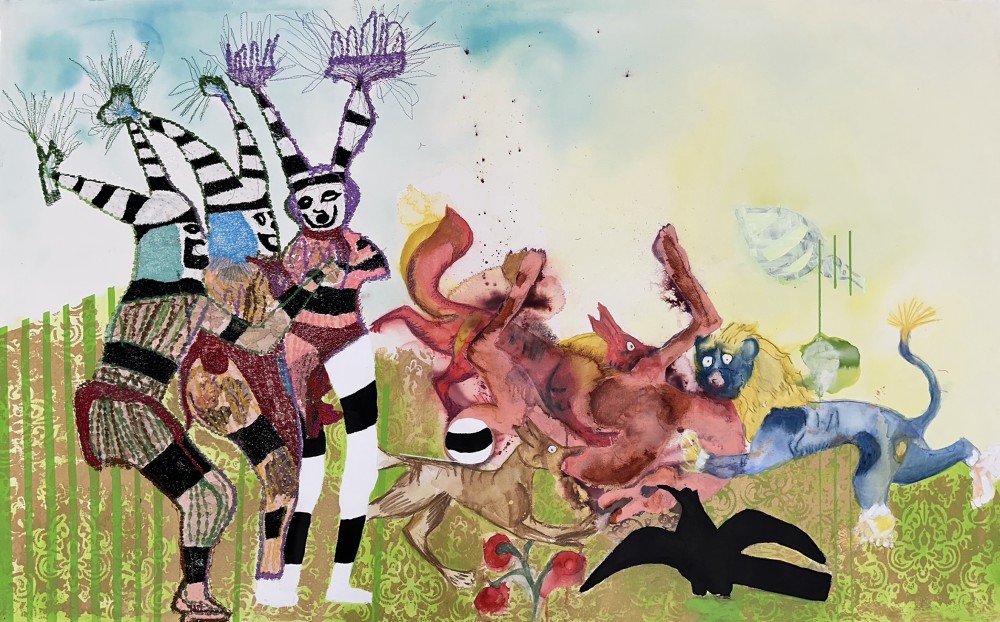
Griselda Rosas: Donde pasó antes (Where it happened before)
Informed by her fluid experiences with the Mexico and US border and life between Tijuana and San Diego, Griselda Rosas deconstructs the ambiguities of identity and place, learned, and generationally passed subjugation, and the legacies of colonization and conflict. She often focuses on the pre-colonial and post- colonial war scenes and the introduction of Catholicism to Indigenous customs in the Americas as part of the Spanish colonial agenda. Rosas examines these histories alongside her roles as an educator and single mother, frequently collaborating with her young son to produce works that pulsate with the energy of an uninhibited child’s eye and hand.
In Donde pasó antes (Where it happened before), mixed media collages comprised of fabrics, cyanotypes, acrylic, watercolor, natural pigments and vivid embroidery are exhibited alongside sculptures of ornamental slingshots—objects loaded with dualities, such a child's toy, and a weapon used today and by the ancient Aztecs. The collages tell stories of colonization and resistance, with horses and wild animals leaping in the scenes against figures in colorful war regalia. Rosas presents a nimble transition of handiwork, care, and conflict between sculptures representing play and warfare and the details of mending and embroidery work— a ritual and practice passed down through generations, from her mother, grandmother, and aunts, and a celebrated indigenous art adorning garments and textiles in Mexican homes.
Taking inspiration from the fairytales and stories that she read to her young son, in addition to children’s make-believe games and toys, Rosas reimagines brilliantly hued scenes appropriated from historical Mexican, European, and Indian documents, fables and myths, including El Lienzo de Tlaxcala (The Codex of Tlaxcala), a colonial-era pictorial codex produced in the second half of the sixteenth century, the illustrated fables of La Jean de La Fontaine dating back to the European Middle Ages, and The Panchatantra, an ancient Indian collection of interrelated animal fables written in Sanskrit verse and prose. These stories deploy metaphors of anthropomorphized animals with human virtues—not unlike those found on Aztec battle regalia.
Rosas' works hover between the recognizable and the unfamiliar, like objects unearthed in an archaeological dig and suspended in the amorphous clouds of a dream or supernatural revelation. Battle and hunting scenes are juxtaposed with modern syncretic festivities in Oaxaca and cyanotypes depicting ancient breast-feeding icons and 17th-century images of the Virgin Mother and Child. Indigenous warriors wear feathered body suits, battle standards on their backs, and hold circular shields; European warriors are dressed in armor or doublets and have oval shields. Old World horses gallop next to New World turkeys.
Rosas' material processes are highly considered, too. The rubber used for her slingshot sculptures is sourced from indigenous communities in Southern Mexico, a similar location to where the Aztecs sourced their rubber; her cyanotypes and watercolors embody a natural and elemental collaboration with light and water. Rosas also incorporates materials that are imbued with her personal memories; for example, the incorporation of faux ostrich skin comes from seeing alligator-booted narcos, drug traffickers in Tijuana—a regalia for another type of war. And she uses the same pimpled-grained fabric to conjure the spread of smallpox introduced by the Spanish conquistadores, which dealt a devastating blow to the Aztecs.
Donde pasó antes (Where it happened before), prompts a questioning of cycles. Rosas' conflation of past and present blurs boundaries and resists binaries to rethink origins, influences, and patterns. Her animated, vibrant drawings and sculptures craft new ways of considering the present by understanding how colonialist images, propaganda and actions are entrenched within our histories.
Griselda Rosas (born in Tijuana, Mexico) received her BFA in painting and printmaking in 2006 at San Diego State University, San Diego, CA, and MFA in sculpture in 2013. Since 2013 she has taught drawing, painting, and embroidery as an adjunct professor at San Diego State University.
Solo exhibitions include Yo te cuido at the Museum of Contemporary Art San Diego and UC Berkeley Art Museum & Pacific Film Archive (BAMPFA) (2023); Forged Dialect, Quint Gallery, La Jolla, CA (2022); and Regata Abscisa, Oceanside Museum of Art, San Diego, CA (2020). Notable group exhibitions include Stories from My Childhood, Northern Illinois University Art Museum, DeKalb, IL (2022); Cannon Gallery Ninth Invitational Exhibition, Carlsbad, CA (2022); First International Festival of Manuports, Kohta, Helsinki, Finland (2021); and San Diego Art Prize Exhibit, Bread & Salt, San Diego, CA (2020); among others.